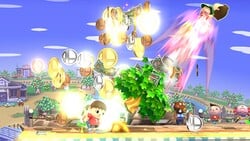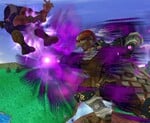Hitstun
- This article is about the mechanic known by the community as hitstun. For the mechanic known officially as hitstun, see hitlag.
Hitstun (known as DamageFly internally) is a period of time after being hit by an attack that a character is unable to act outside of directional influence or teching. It is directly dependent on knockback, so at a same damage percentage, an attack like Falcon Punch will have more hitstun than one like Thunder Jolt. Each Smash game has a programmed value that is multiplied by the amount of knockback received to determine the amount of frames a character is locked in hitstun after being hit; for example, Melee has a hitstun multiplier of 0.4 frames per unit of knockback, so a hit that deals 100 units of knockback will leave the target in hitstun for 40 frames.
Hitstun is an essential component of combos, as the basis of a combo is to have enemies trapped in hitstun while constantly being attacked. As a result, games that have more hitstun for equivalent knockback open up more potential combos.
In Super Smash Bros.[edit]
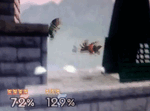
The amount of hitstun in the original SSB is much higher than in the subsequent Super Smash Bros. games, being equal to 0.533× of the inflicted amount of knockback. The multiplier is so high that long, highly damaging combos are commonplace, with competitive matches being heavily centralized around them. Zero-to-death combos are not uncommon in SSB, as every character in the game except Samus is capable of performing a zero-death using their normal moves.
In Super Smash Bros. Melee[edit]
The amount of hitstun in Melee is a significantly lower 0.4× multiplier, making Melee a less combo-oriented game, and zero-to-death combos a rarity. However, with the increased falling speeds, and generally faster and more varied movement, combos remain frequent, though generally more difficult to pull off consistently.
A peculiar property of hitstun in Melee is how it is handled for characters landing when taking knockback below tumbling range. In Smash 64, the character simply remains in their flinching animation on the ground, and the hitstun proceeds as usual. In Melee, however, if the character's launch speed higher than 0.5 (equal to 16.67 units of knockback) when touching the ground, they go into their landing animation, and the hitstun is overriden by their 4 frames of normal landing lag (slightly higher for some characters). Combined with ASDI allowing characters to move from the air to the ground (which is forbidden for standard SDI), this property allows characters to "tank" attacks at low percents to punish them more effectively, and is likewise the main factor behind crouch canceling's defensive utility. Hitstun carrying over to the ground as in SSB, on the other hand, is generally uncommon, and the launch speed required is too low for any individual attack to benefit significantly from it; however, knockback stacking can cause a followup attack to inflict a noticeable amount of hitstun while lowering a character's launch speed to under 0.5, making it relevant for certain characters' combos. The most notable example is Falco's pillaring combos on platforms, where he can spike the opponent close enough to them after a shine and have them remain in hitstun instead of landing, as both moves' launch speeds end up mostly canceling each other out, but the down aerial carries all the hitstun.
In Super Smash Bros. Brawl[edit]
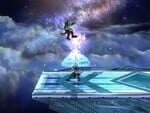
Brawl has the same hitstun multiplier Melee has. However, when hit by an attack that causes tumbling (or reeling), characters can now air dodge after 13 frames of hitstun, or use an aerial attack after 25 frames, regardless of the actual amount of hitstun they sustained. This new mechanic, known as hitstun canceling, drastically reduces the effective hit advantage granted to the attacker, especially at higher knockback values. For example, a character taking 100 units of knockback in Melee would invariably sustain 40 frames of hitstun, but in Brawl, they will only be in actual hitstun for 13 frames if they air dodge, or 25 if they attack; if this knockback value is doubled, the Melee character would sustain 80 frames of hitstun, while the Brawl character will still only be in true hitstun for 13 or 25 frames.
This change significantly reduces the amount of true combos, and means the only attacks that can truly combo are those that deal low enough knockback to not cause tumbling while having low enough ending/landing lag to followup (such as chain throws and Sheik's forward tilt), and at tumble percentages, very few attacks, if any, are fast enough to followup within 13 frames before the opponent can air dodge, such as Meta Knight's up aerial. Any attack that deals even slightly more knockback or has slightly more ending lag will require the player to read the opponent's action to successfully followup. This new mechanic also allows launched characters to act before their knockback wears off, which allows characters to perform certain actions during knockback to reduce their aerial momentum, allowing them to survive blows that would otherwise KO them.
The much slower falling speeds, loss of L-canceling with most aerials not having their landing lag fully compensated, and generally slower movement also reduce the amount of possible combos, though the effect of these is minuscule compared to the ability to act so early out of hitstun.
Conversely to hitstun canceling, Brawl also no longer allows characters taking knockback below tumbling level to land during hitstun, with the character instead remaining in their flinching animation and not landing until the hitstun is over. In combination with crouch canceling no longer reducing knockback taken, this weakens characters' defensive options at percents before hitstun canceling is possible.
In Super Smash Bros. 4[edit]
In Smash 4, hitstun has a very slightly altered formula: by default, the result is decreased by one frame compared to Melee and Brawl, but if the character is sent tumbling (not reeling) or launched by an electric attack, one more hitstun frame is added, with both factors being able to stack. For example, if a character that sustains 100 units of knockback is sent reeling, they will be in hitstun for 39 frames, but if they are sent tumbling by an electric attack, they will be in hitstun for 41 frames.
More significantly, however, while the ability to act out of hitstun with an air dodge or aerial attack returns from Brawl, its effect is considerably less pronounced. Characters in Smash 4 can only air dodge out of hitstun after at least 40 frames, and if their current launch speed is lower than 2.5; likewise, they can only cancel hitstun with an aerial attack after at least 45 frames, and if their current launch speed is lower than 2. For reference, launch speed starts at 0.03× of the knockback inflicted (so in the former example, it would start at 3), and decreases by 0.051 every frame. As a result, hitstun canceling not only occurs much later than in Brawl, but is further delayed as knockback increases (starting to increase after roughly 56 frames of hitstun to cancel with an aerial, or 59 frames to cancel with an air dodge), to the point of becoming irrelevant at extreme knockback values. The gravity penalty for vertical launch speed is also taken into account, giving characters slightly better hitstun cancel windows the lower their gravity is.
The significantly weakened hitstun canceling, coupled with the cast's generally increased gravity and falling speeds, makes true combos past low percentages possible again, and renders momentum canceling effectively impossible, allowing moves to KO earlier. Furthermore, air dodging to cancel hitstun actually marginally worsens horizontal endurance, as similarly to Brawl, a fighter is not able to begin opposing their momentum with directional inputs until all of the knockback momentum is gone (despite hitstun actually ending a little earlier than this). Because of this, characters such as Sheik and Captain Falcon are indirectly buffed, as their comboing abilities from previous games have been restored, while Brawl newcomers such as Meta Knight and Zero Suit Samus also benefit by gaining a similar or even greater combo potential. However, with the retained ability to air dodge or attack out of hitstun at higher percentages, gravity increasing knockback as in Brawl, and falling speeds still being slower than in Melee, true combos at higher percentages are exclusive to a few characters (and even then, they must not be at high percentages themselves), making them less prevalent than in Melee and especially the original SSB.
Hitstun in Smash 4 has received other minor adjustments:
- Characters taking knockback below tumbling level can land during hitstun as in Melee, which no longer depends on their launch speed when touching the ground. However, the hitstun now carries over to their landing animation, taking priority over the standard 4 frames of hard landing lag (or slightly higher for some characters), and in this case, it is also one frame longer than usual.
- Characters bouncing off surfaces due to knockback have their hitstun reduced by 0.8× relative to the initial amount, with the exception of grounded meteor smashes. This does not affect their hitstun cancel windows.
- For Rosalina & Luma, Luma uses an altered hitstun formula if only Rosalina is hit, equal to 0.27× of the knockback taken by her. This effectively causes Luma to take 67.5% of Rosalina's hitstun, allowing it to retaliate faster against attackers.
In Super Smash Bros. Ultimate[edit]
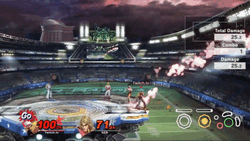
Ultimate retains the 0.4× multiplier used since Melee to determine the base amount of hitstun, but always reduces the result by one frame, even if the target is sent tumbling or hit by an electric attack, unlike in Smash 4. More significantly, however, hitstun is affected by the new speed-up effect used for tumbling knockback (commonly dubbed "balloon knockback" by the community), which causes characters to be launched faster as they take higher knockback. As a result, after tumbling starts happening, the effective hitstun frames increase at a slower rate in comparison to previous Smash games. For example, 90 and 145 units of knockback, which would inflict 36 and 58 frames of hitstun (respectively) in Smash 4, inflict 33 and 41 frames in Ultimate. Oddly, reeling can sometimes cause an extra frame of hitstun at tumbling percents, but the cause for this is unknown.
To determine the magnitude of the knockback speed-up effect, the game takes the FAF after hitstun (for example, 40 for 100 units of knockback), and calculates a frame speed multiplier between 1× and 6×, which is determined by the FAF's placement between 30 and 80 (though since the effect depends on tumbling, it cannot normally apply to hitstun below 31 frames). This speed multiplier is then applied to the first frame of knockback, and multiplied for subsequent frames by the result of (initial_faf * 0.3 - faf) / (initial_faf * 0.3 - initial_faf), where faf is the FAF minus the previous frame's speed multiplier. For example, with 39 frames of hitstun, the initial FAF would be 40, resulting in a frame speed multiplier of 2× for the first knockback frame, which would then decrease to approximately 1.857× on the second frame (multiplied by 0.9285×). Due to the algorithm capping the FAF at 80, the speed-up effect stops scaling for knockback above 200 units, after which hitstun increases at a rate of (knockback - 200) * 0.25.
As a result of these changes, hitstun remains unchanged in comparison to Smash 4 if a move's knockback is low enough, but is decreased otherwise, giving characters less time to combo opponents at higher percents. However, due to the cast's generally improved mobility (namely faster dashing speeds, air speeds, jumpsquats, and full hop speeds), lower landing lag, and the effect of rage being weakened, combo potential is overall slightly increased up to mid percents, with a detrimental effect only at higher knockback ranges where combos are less common. Furthermore, while hitstun canceling is still possible, and its launch speed thresholds take the knockback speed-up effect into account, its earliest windows of 40 and 45 frames do not, thus providing a considerably smaller benefit. Worth noting, however, is that moves with set knockback do not use this effect, meaning their hitstun at tumble percents is only reduced by one frame compared to Smash 4, and hitstun canceling can still have a noticeable effect on moves with high enough set knockback (such as Luigi's down taunt).
Ultimate retains Smash 4's adjustments to landing hitstun, hitstun reduction when bouncing off surfaces, and Luma's unique hitstun factor, the latter which is now comparatively lower due to using the same speed-up magnitude as Rosalina. As a new minor adjustment, attacks that cause flinching always inflict a minimum of 4 frames of hitstun, slightly increasing it for attacks with extremely low knockback (such as the late hit of Luigi's Super Jump Punch).
Hitstun modifiers[edit]
A new property of hitstun in Ultimate is the addition of hitstun modifiers, which can add or deduct hitstun frames to/from individual moves regardless of their knockback, allowing them to combo better or worse (respectively) than they normally would. These are mainly present in neutral attacks, which have additional hitstun to connect better, but a few other moves use them as well, such as Fox's down tilt (3 extra frames), and the linking hits of Samus and Dark Samus's up aerials (10 less frames), with the intention of either comboing better into their next hits and other moves, or preventing certain followups, both without altering their knockback or lag. Hitstun modifiers do not alter how early attacks can cause tumbling, and the resulting hitstun is still reduced by the knockback speed-up effect.
List of moves with hitstun modifiers[edit]
Due to a glitch, even if a move has a hitstun modifier only coded for specific hitboxes, the game applies the multiplier to all hitboxes of the move during frames where the specified hitbox is present. Likewise, if a move has different hitstun modifiers for each hitbox, the modifier for the hitbox with the highest ID number applies to all hitboxes, and other modifiers are ignored. This glitch is also present for shieldstun multipliers. However, some hitstun modifiers are marked as "revised" and appear to function normally; these are denoted by an asterisk in the following table.
| Character | Attack | Modifier |
|---|---|---|
| Banjo & Kazooie | Neutral attack | 5 (hit 1) 6[1] (hit 2) 3 (rapid jab) |
| Breegull Blaster (clean) | 6 | |
| Bayonetta | Neutral attack | 8 (hit 1) 10 (hits 2-3) 2 (rapid jab) |
| After Burner Kick (upward) | 1 | |
| Witch Twist (last hit) | ||
| Bowser | Bowser Bomb (grounded, hit 1) | 8 |
| Bowser Jr. | Neutral attack (hit 2 and rapid jab) | 3 |
| Down tilt (hits 1-2) | 4 | |
| Byleth | Neutral attack | 7 (hit 2) 3 (rapid jab) |
| Captain Falcon | Neutral attack | 3 (hit 2) 2 (rapid jab) |
| Raptor Boost (grounded) | 3 (3.1.0 onward) | |
| Charizard | Neutral attack (hits 1-2) | 2 |
| Corrin | Neutral attack (hits 1-2 and rapid jab) | 2 |
| Forward smash (charging loop hits) | 3 (3.0.0 onward) | |
| Dark Pit | Neutral attack (hits 1-2) | 2 |
| Dark Samus | Neutral attack (hit 1) | 4 |
| Up aerial (loop hits) | -10[2] | |
| Dr. Mario | Down tilt | 3 (7.0.0 onward) |
| Duck Hunt | Rapid jab | 2 (7.0.0 onward) |
| Falco | Rapid jab | 2 |
| Fox | Down tilt | 3 |
| Greninja | Rapid jab | 2 |
| Hero | Neutral attack (hits 1-2) | 7 |
| Forward tilt (hit 1) | 3 | |
| Kazap (hit 1) | 10 | |
| Kaboom (hit 1) | 4 (8.0.0 onward) | |
| Magic Burst (looping hits) | 2 (5.0.0 onward) | |
| Metal Slash | 6 | |
| Ice Climbers | Neutral attack (Popo, hit 1) | 2 |
| Incineroar | Neutral attack (hit 2) | 2[3] (3.1.0 onward) |
| Inkling | Rapid jab | 2 |
| Isabelle | Neutral attack | 14 (8 before 4.0.0) |
| Jigglypuff | Pound | 2 (6.0.0 onward) |
| Kazuya | Neutral attack | 8* (hit 1) 11 (hit 2) 9* (hit 5, closest grounded hitboxes) 4* (hit 6, closest hitboxes) 9* (hit 7, closest hitboxes) 6* (hit 8, closest hitboxes) |
| Up tilt (hit 1) | 1/3* (grounded/aerial) | |
| Down tilt | 17 | |
| Up-forward tilt (hits 1-3) | 10* | |
| Down-forward tilt (hit 1) | 4/8* (grounded/aerial) | |
| Crouch attack | 22/16* (body/arm) | |
| Forward crouch attack | 11 | |
| Back crouch attack | 9 | |
| Left Splits Kick | 10* | |
| Down smash | 5* | |
| Devil Blaster (late) | 10* | |
| Wind God Fist | 15/13* (grounded/aerial, clean) 17/13* (grounded/aerial, late) | |
| Electric Wind God Fist | 19/14* (grounded/aerial) | |
| Spinning Demon to Left Hook (hit 1) | 7 | |
| Side taunt | 8* (hit 1) 10* (hits 2-4) 9* (hit 3) | |
| Ken | Forward tilt (tapped, close) | 9[4] |
| Down tilt (tapped) | 1 (3.1.0 onward) | |
| Hadoken (early) | 5[4] | |
| Nata Otoshi Geri (hit 1) | 2 | |
| King Dedede | Neutral attack | 5 (hits 1-2) 2 (rapid jab) |
| King K. Rool | Neutral attack (hits 1-2) | 4 |
| Link | Up smash (hits 1-2) | 3* (9.0.0 onward) |
| Little Mac | Neutral attack (hit 2) | 2 |
| Up tilt | 2 (13.0.0 onward) | |
| Lucas | Neutral attack (hit 2) | 2 |
| Meta Knight | Rapid jab | 2 |
| Mewtwo | Neutral attack | 6 (hit 1) 3 (rapid jab) |
| Mii Gunner | Neutral attack | 1 (hit 1) 4 (hit 2) |
| Mii Swordfighter | Stone Scabbard (hit 1) | 4 |
| Min Min | Neutral attack | 8 (hits 1-2) 3 (rapid jab) |
| Mr. Game & Watch | Rapid jab | 4 |
| Forward aerial (hit 1) | 5 | |
| Fire (grounded, hit 1) | 10 | |
| Mythra | Neutral attack | 7 (hit 1) 8/12* (hit 2, close/far; 8 for all before 12.0.0) 4 (rapid jab) |
| Up smash (hits 2-4, ground-only) | 10 | |
| Lightning Buster | 5 (hit 1, clean) 2 (hits 2-3 uncharged, hits 2-4 fully charged) | |
| Ray of Punishment / Chroma Dust (slash) | 15 | |
| Pac-Man | Neutral attack (hit 1) | 4 |
| Palutena | Neutral attack (hit 1) | 4 |
| Neutral aerial (hit 6) | -13 (7.0.0 onward) | |
| Piranha Plant | Neutral attack | 6 (hit 2) 4 (rapid jab; 3 before 3.1.0) |
| Pit | Neutral attack (hits 1-2) | 2 |
| Pyra | Neutral attack | 7 (hit 1) 8/12* (hit 2, close/far; 8 for all before 12.0.0) 4 (rapid jab) |
| Flame Nova (loop hits) | 10 | |
| Blazing End | 20[5] (travel) 25 (start and loop hits) | |
| R.O.B. | Neutral attack (hit 1) | 5[6] |
| Richter | Neutral attack | 2 (hits 1-2) 3 (rapid jab) |
| Ridley | Rapid jab | 2 |
| Robin | Neutral attack (hits 1-2 and rapid jab) | 2 |
| Rosalina & Luma | Neutral attack (Rosalina) | 6 (hit 1) 8 (hit 2) 3 (hit 3 and rapid jab) |
| Neutral attack (Luma) | 5 (hit 1) 6 (hit 2) 3 (rapid jab) | |
| Ryu | Forward tilt (tapped, close) | 2[4] |
| Down tilt (tapped) | 1 (3.1.0 onward) | |
| Shakunetsu Hadoken (loop hits) | 10 (clean) 4 (late) | |
| Samus | Neutral attack (hit 1) | 4 |
| Up aerial (loop hits) | -10[2] | |
| Sephiroth | Neutral attack | 2 (hit 1) 3 (hit 2) |
| Sheik | Rapid jab | 2 |
| Up tilt (hit 1) | 2 (9.0.0 onward) | |
| Shulk | Neutral attack | 2 (hit 1) 5 (hit 2) |
| Up smash (hit 1) | 3[7] (9.0.0 onward) | |
| Simon | Neutral attack (hits 1-2) | 2 (hits 1-2) 3 (rapid jab) |
| Snake | Neutral attack (hit 1) | 2 |
| Forward tilt (hit 1) | ||
| Sonic | Neutral attack | 8 (hit 1) 4 (hit 2) |
| Sora | Neutral attack | 11/8* (hit 1, clean/late) 10* (hit 2) |
| Forward tilt | 13/12* (linking hit 1) 10* (hit 2) | |
| Up tilt (hit 6) | 4* | |
| Down tilt | ||
| Neutral aerial | 2/4/10* (frame 8) 1/2/4* (frames 9-10) | |
| Forward aerial | 4/6/8* (frames 10-11) | |
| Firaga | 9/7/5* (first shot, clean/mid/late) 1/-1/-3* (repeated shots, clean/mid/late) | |
| Blizzaga (last hit) | 8/6* (clean/late) | |
| Steve | Neutral attack | -10* (no weapon) -7/-5* (Stone/Gold) -5/-3* (other) |
| Forward tilt | ||
| Neutral aerial | ||
| Terry | Neutral attack (hits 1-2) | 1 |
| Villager | Neutral attack | 7 (hit 1; 2 before 8.0.0) 11 (hit 2; 2 before 8.0.0) |
| Up tilt (hit 1) | 2[7] (8.0.0 onward) | |
| Wii Fit Trainer | Neutral attack (hit 1) | 4 |
| Young Link | Rapid jab | 2 |
| Grab aerial | 4 (7.0.0 onward) | |
| Zelda | Neutral attack | 2 (hit 2) 3 (rapid jab) |
| Zero Suit Samus | Neutral attack (hit 1) | 2[8] |
| Plasma Whip (held final hit) | 4 |
Notes[edit]
- ^ Has a specified modifier of 5 for the closest hitbox, but is overriden by this modifier due to the aforementioned glitch
- ^ a b Only specified for the body hitbox, but applies to all hitboxes due to the aforementioned glitch
- ^ Only specified for the middle hitbox, but applies to all hitboxes due to the aforementioned glitch
- ^ a b c Only specified for the hitbox against grounded targets, but applies to both due to the aforementioned glitch
- ^ Has a specified modifier of 40 against grounded opponents, but is overriden by this modifier due to the aforementioned glitch
- ^ Only specified for the closest hitboxes, but applies to all due to the aforementioned glitch
- ^ a b Only specified for the hitbox against aerial targets, but applies to all due to the aforementioned glitch
- ^ Has specified modifiers of 10 and 6 for the closer hitboxes, but they are overriden by this modifier due to the aforementioned glitch
